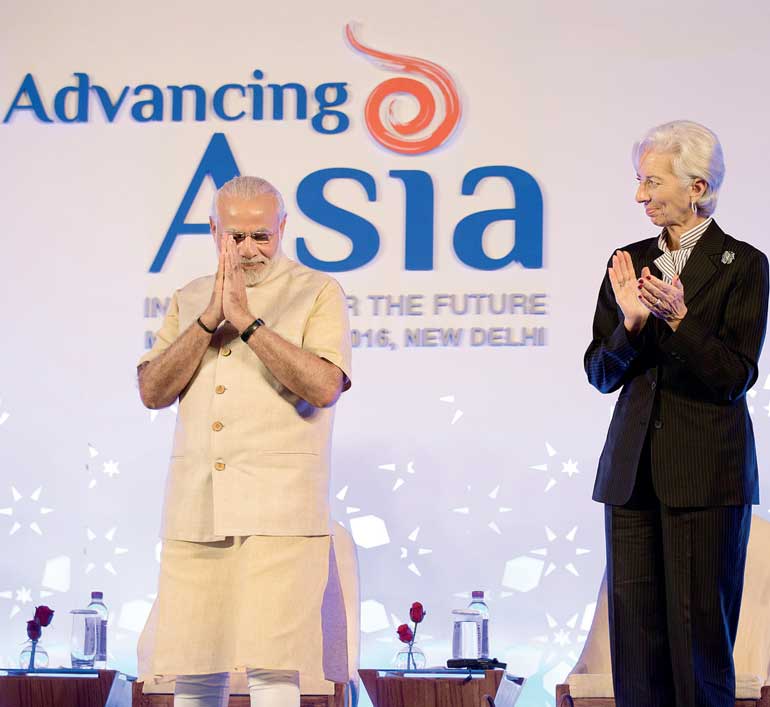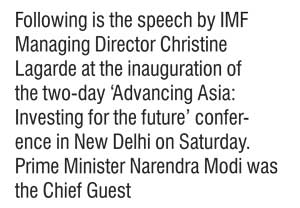Monday Mar 17, 2025
Monday Mar 17, 2025
Monday, 14 March 2016 00:00 - - {{hitsCtrl.values.hits}}

Good morning. I am delighted to be back in India to co-host this landmark conference on Advancing Asia. Let me thank Prime  Minister Modi, Finance Minister Jaitley, and Governor Rajan for their commitment to this joint initiative.India and the IMF go back a long way together—in fact, India was a founding member of the Fund more than 70 years ago. Our partnership has gone from strength to strength ever since.
Minister Modi, Finance Minister Jaitley, and Governor Rajan for their commitment to this joint initiative.India and the IMF go back a long way together—in fact, India was a founding member of the Fund more than 70 years ago. Our partnership has gone from strength to strength ever since.
India, Asia, and the world
It is fitting that we meet in India: the world’s fastest growing large economy; on the verge of having its largest and youngest ever workforce; and, in a decade’s time, set to become the world’s most populous country.
So India stands at a crucial moment in its history—with an unprecedented opportunity for transformation. Important reforms are already underway. Think, for example, of Make-in- India and Digital India. And with the promise of even more reforms to come, India’s star shines bright.
In about 10 days, India, Nepal and many other countries will be celebrating the festival of Holi (festival of colour), which heralds the coming of spring. I am not suggesting that we cover each other with colour or spray water as is customary (we will leave that to the children). But I do think today we should celebrate India’s achievements—and Asia’s achievements.
Asia has a lot to be proud of. It is the world’s most dynamic region and today accounts for 40 percent of the global economy. Over the next four years—even with slightly declining momentum—it stands to deliver nearly two-thirds of global growth.1
Given this vital economic role, making the most of Asia’s dynamism is of great interest to the entire world.
What gains can the region build on? How can it respond to today’s global economic challenges? And, above all, what can it do to realise its future potential?
I. Building on recent gains
Asia’s rapid integration into the world economy has been one of the most striking global developments of the last generation. In that relatively short time, many countries across this vast and diverse region have achieved economic “miracles,” and several have become powerhouses of the global economy.
For the past 25 years—the Asian crisis notwithstanding—the region’s economy has grown by around 6% a year. In the aftermath of the recent global financial crisis, Asia was a rare bright spot.
This economic transformation has supported social development. Over the past 35 years, this region has been the world’s leader in reducing poverty.2 Education and health outcomes have improved significantly. People’s living standards have been raised.
Asia has also become a byword for innovation. Each day, almost everyone around the world is touched by Asian technology. Cars, smartphones and televisions spring to mind—but think also of biotechnology, commercial satellites, and renewable energy.
This increased interconnectedness means that Asia now affects the world more than ever before; by the same token, Asia is now more deeply affected by global economic developments than ever before—and must respond to them.
II. Global economic challenges and Asia’s response
Indeed, the global economy faces many challenges: volatile markets and capital flows; economic transitions and financial tightening in many countries; the large drop in commodity prices, including oil; and escalated geopolitical tensions.
What should be Asia’s response? Some of the broad areas for action are well-known:
Supportive monetary policy—consistent with price and external stability objectives;
Growth-friendly fiscal measures; and,
Macro-prudential measures to safeguard financial stability.
The policy specifics, of course, vary across countries and according to circumstances. In all cases, however, it is safe to say that structural reforms are key—to boost competitiveness, growth, and jobs. To give a few examples:
In China: improving the allocation of credit to help rebalance the economy away from debt-led investment.
In Japan: tackling dual labour markets, liberalising product markets, and reforming corporate governance.
In India: enhancing the efficiency of product markets, encouraging private investment, and improving infrastructure.
In many countries—from emerging markets to low-income nations—strengthening the business environment and developing bond markets.
Successfully dealing with these kinds of structural issues will not only support Asia’s near- and medium-term prospects, but also secure the foundations on which to unlock the region’s exciting future potential.
III. Unlocking Asia’s potential
Indian Nobel Laureate Rabindranath Tagore once said: “You can’t cross the sea merely by standing and staring at the water.” Asia has done a lot more than that! And yet, there is still a lot to do.
Across the region as a whole, income inequality has worsened since 1990. A new IMF staff paper finds that income inequality has since increased in 15 of 22 Asian economies.3 Asia remains home to two-thirds of the world’s poor, many of whom live in India.4 In most of the region, women and youth are still greatly underrepresented in the labour market.
Seen from another perspective, however, these concerns can be opportunities.
What if income inequality could be reversed, poverty further reduced, and women and young people economically empowered? What if growth could be made more inclusive and sustainable? What if Asia’s 4.4 billion people could each realise their full potential?
We can imagine the possibilities. The question is how to realise them:
First, broadening access to services like health and finance is essential. India, for example, is targeting universal access to banking services by 2018. Through the Pradhan Mantri Jan- Dhan Yojana5 scheme, over 210 million previously unbanked people have opened a bank account since August 2014, with social transfers paid directly.
Second, leveraging the impact of fiscal policy is essential. This means targeting social spending on the neediest. Countries such as the Philippines, for example, have pioneered conditional cash transfer programs. Effective redistribution also means avoiding costly across-the-board subsidies, and making taxes more progressive. With the Aadhaar system, India has come up with a groundbreaking way to deliver targeted subsidies. Almost one billion people have Aadhaar numbers, and the potential to use this for delivering payments and other services—including for women—is tremendous.
This brings me to my third point: empowering women is essential—whether by enhancing girls’ access to high quality education, dismantling legal and logistical barriers to economic participation, or making it more practical for women to combine a job and a family. An initiative of Prime Minister Modi’s government, for example, is to improve women’s welfare services under Beti-Bachao, Beti-Padhao.6 Tackling duality and informality in labour markets would also bring more young people into formal jobs, providing a particularly welcome boost in countries with aging populations.
Fourth, with more than 800 million people in Asia lacking access to water, sanitation and electricity, inclusive growth means more investment in infrastructure—and making that investment more efficient.
Fifth, even-greater trade integration can support more sustained growth, especially for India and other countries in South Asia. Multilateral trade liberalisation has the potential to be globally welfare-enhancing. If, however, progress at that level remains slow, comprehensive regional trade agreements can help to lower tariff and non-tariff barriers, and incorporate new areas like services.
Finally, there is the challenge of climate change. Last December, 186 countries submitted mitigation pledges in the context of the historic Paris Agreement. Now they must keep their promises, including through carbon pricing and energy subsidy reforms. Clearly, Asia has a massive stake in this effort.
Yes, these challenges are daunting—and yes, I am convinced that Asia can meet them. I have visited Asia many times, and I have always been struck by the vibrancy, energy, and can-do attitude of its people.
They have shown the world before what Asia can achieve—and they will show the world again.
Asia and the IMF
I am pleased to say that the IMF is Asia’s partner in this endeavour—and the region’s increasingly important role is increasingly reflected in our relationship.
Earlier this year, quota and governance reforms came into effect that enhance the representation of emerging Asian economies within our 188 member countries. One consequence is that India now joins China and Japan among the Fund’s top ten shareholders.
Also, late last year, the decision was taken to include the renminbi as the second Asian currency in the IMF’s SDR currency basket—joining the yen, of course.
Yet another milestone in our partnership is that, in 2018, Indonesia will host the IMF Annual Meetings.
And here in New Delhi—I am delighted to announce—the Fund is opening a new Regional Training and Technical Assistance Centre for South Asia. This will be for us the first fully integrated centre and a model for our future capacity development work. I would like to warmly thank the Government of India for offering to host the centre, and for their substantial financial commitment. I would also like to thank the other member countries— Bangladesh, Bhutan, Maldives, Nepal, and Sri Lanka—for joining with India, the IMF, and other external partners like Australia and Republic of Korea, in making this exciting initiative happen.
Conclusion: Asia’s global leadership
Mahatma Gandhi once said: “The future depends on what we do in the present.”
This region’s dynamism presents a historic opportunity to invest now in the future—and to advance Asia.
Doing so will not only put Asia on the path to sustained growth, but also strengthen its role in the global economy—as a key contributor and as a leader for the 21st Century.
Thank you.
Footnotes
1 IMF Regional Economic Outlook. Asia and Pacific: Stabilising and Outperforming Other Regions, April 2015
2 IMF Working Paper: Asia’s Quest for Inclusive Growth Revisited
3 IMF Working Paper: Sharing the Growth Dividend: Analysis of Inequality in Asia
4 IMF Working Paper: Asia’s Quest for Inclusive Growth Revisited
5 “Prime Minister’s Community Wealth-Building Scheme”
6 “Save girl child and educate her”
Discover Kapruka, the leading online shopping platform in Sri Lanka, where you can conveniently send Gifts and Flowers to your loved ones for any event including Valentine ’s Day. Explore a wide range of popular Shopping Categories on Kapruka, including Toys, Groceries, Electronics, Birthday Cakes, Fruits, Chocolates, Flower Bouquets, Clothing, Watches, Lingerie, Gift Sets and Jewellery. Also if you’re interested in selling with Kapruka, Partner Central by Kapruka is the best solution to start with. Moreover, through Kapruka Global Shop, you can also enjoy the convenience of purchasing products from renowned platforms like Amazon and eBay and have them delivered to Sri Lanka.
Discover Kapruka, the leading online shopping platform in Sri Lanka, where you can conveniently send Gifts and Flowers to your loved ones for any event including Valentine ’s Day. Explore a wide range of popular Shopping Categories on Kapruka, including Toys, Groceries, Electronics, Birthday Cakes, Fruits, Chocolates, Flower Bouquets, Clothing, Watches, Lingerie, Gift Sets and Jewellery. Also if you’re interested in selling with Kapruka, Partner Central by Kapruka is the best solution to start with. Moreover, through Kapruka Global Shop, you can also enjoy the convenience of purchasing products from renowned platforms like Amazon and eBay and have them delivered to Sri Lanka.